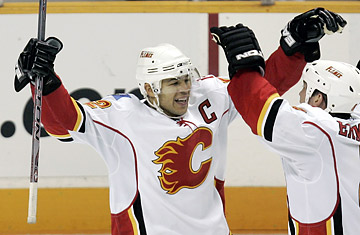
Calgary Flames Jarome Iginla (L) celebrates with teammate Anders Eriksson after Iginla scored the game-winning goal in the overtime period against the San Jose Sharks during their NHL hockey game in San Jose, California, January 3, 2008.
"You know, I don't understand why you're playing that white man's game. So stupid." For Gerald Coleman, a goaltending prospect in the Anaheim Ducks organization, those words still sting, like a high-stick to the forehead. At the time Coleman, an African-American who grew up in Chicago, was in the ninth grade, and he just told the high school basketball coach that he was picking hockey over hoops. Despite those discouraging words, and the frequent racial taunts he received while playing youth hockey, Coleman stuck with the skates, and became a promising pro.
To say that Coleman, now 22, is an exception to the rule is a vast understatement. Few black kids have made the same choices as him. Even fewer face this decision in the first place, since most African-American kids ignore hockey altogether. "I just never thought about playing that sport," says DeQuanta Higgins, 14, after a game of pickup hoops with his brother and cousins in Atlanta. "It's just fun playing basketball."
The NHL is hoping, once and for all, to change that perception. During the first intermission of Sunday's NHL All-Star game in Atlanta, the league is honoring Willie O'Ree, who broke hockey's color barrier 50 years ago. But half a century later, with hockey in desperate need of new fans to restore its fading relevance in the U.S., the game still holds very little appeal among blacks.
Out of the 700 or so players on NHL rosters today, only 12 are black — a level that has remained flat over the last decade. "Sport as an institution doesn't just fall out of the sky," says Earl Smith, a Wake Forest University sociologist who wrote about blacks in hockey in his 2007 book Race, Sport and the American Dream. "It has to be embedded in the community, in the society the sport is trying to reach. For the NHL, it's a losing proposition."
Not that hockey hasn't tried to reverse its luck. Since 1995, the league has spent over $6 million to expand its Diversity Program, which O'Ree, 72, helps direct. When the NHL started its diversity initiative, there were 5 inner-city hockey programs in North America. Now, there are 39. This year, the league has expanded its "Hockey in the Hood" tournament to include more teams. Coleman himself is a product of these efforts. "There are more kids of color playing hockey today than ever before," says O'Ree, though there's no statistical proof to back this claim.
But even if it's true that more blacks have taken up hockey, the sport still lacks a fan base in urban areas. And luring more blacks to hockey might be an impossible task. The sport hasn't been particularly kind to blacks. The game is littered with racial hostilities toward black players, from both fans and opposing players. While the vitriol isn't as vicious as it was in O'Ree's day, Coleman has heard the n-word on the ice; just five years ago, some slob threw a banana at ex-Carolina Hurricanes goaltender Kevin Weekes during a playoff game.
The sport also faces structural challenges for inner-city players. "You have to make it more accessible," says Calgary Flames star Jarome Iginla, who grew up in Edmonton and is one of the best black players of all-time. "Basketball courts are everywhere. Baseball diamonds, football fields, soccer fields, all those things are readily available. Hockey, unfortunately, has more obstacles."
There are few rinks in inner cities, and where there are facilities, you have to pay for ice time often at very odd morning and evening hours. And unless you live by a frozen Saskatchewan pond, you can't just round up your buddies for a pickup game. Between equipment, travel to rinks, and ice fees, hockey is also prohibitively expensive for many urban families. "How are you going to convince parents to pay $6,000 so their kids can play hockey?" asks Coleman. The NHL could invest more money to subsidize these costs for potential players, but with so few African-American pros in the sport today, who could these kids emulate? Why would they even bother with hockey, when they see so many African-Americans succeeding in basketball, football, and other sports?
Bottom line: hockey needs a transcendent African-American star, a Tiger Woods, to market the game to a black audience. "If you had somebody of that caliber who was African-American, then, yeah, I think that would break the barrier," says James Jemison, a black hockey fan from Atlanta. Iginla is great, but as a Canadian who grew up in hockey-mad Alberta, his backstory isn't that surprising.
How long might we have to wait for such a player? "I'd say 10-15 years," says veteran San Jose Sharks forward Mike Grier, an African-American from the Boston area.
